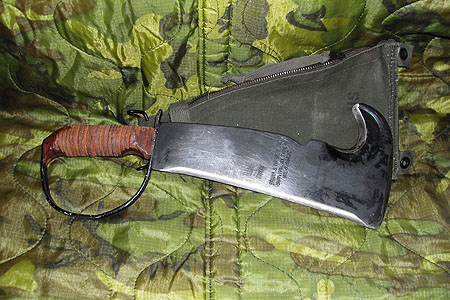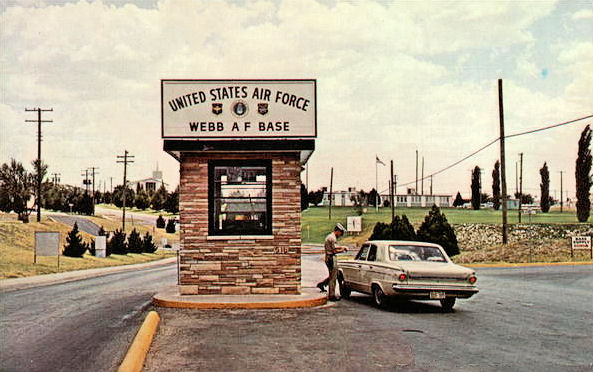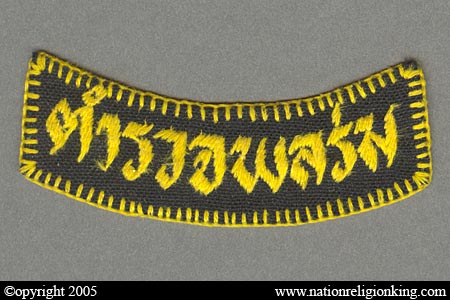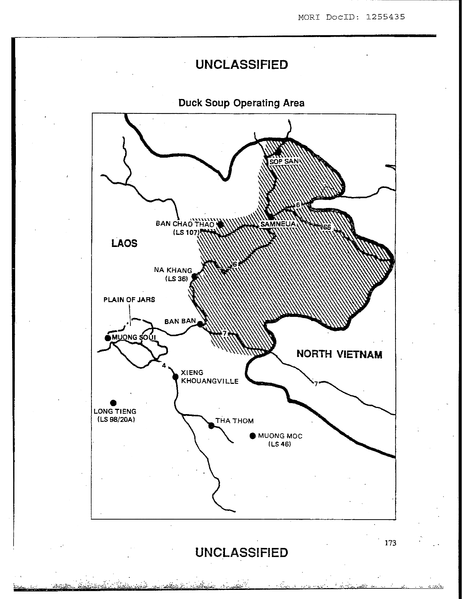Akkrat and the PARU
I have spoken many times in my posts about Akkrat, a Thai mercenary and part of Bill Lair's clandestine army in Thailand. I knew what his last name was, but it was multi-sylable and even if I knew it, I couldn't spell it. He was my indigenous (indig) counterpart when I was in Laos. We became good friends and each of us understood the other's job. When it came to ground operations, he was the team leader. I respected his intuition and savvy. When it came to the air operations, I was in charge. Together, we made a really good team. He was a seasoned fighter having been at war for four years. He was six years older than me, and had a lot of experience in fighting the Pathet Lao. In our military terms he was probably a sergeant, certainly not an officer. He spoke his native tongue of course, but also English, French, and Lao. All PARU personnel were at least high school graduates, and most spoke a
language from a neighboring country in addition to Thai. They were
trained at a jungle camp in central Thailand and organized like the US
Army Special Forces. Akkrat was the indig equivalent of Lt. Peterson, the 1-0 of Team Falcon. He had been to the U.S. Army Ranger School in the states in either 1959 or 1960. Counter-guerrilla tactics were one of the PARU specialties. Akkrat's father had been employed by the French as an interpreter during the French wars against the Vietnamese and Laotians in the late 1940's and 1950's. Bill Lair had been asked by Tony Poe, one of the CIA station chiefs in Laos, for some of Lairs mercenaries. Akkrat had been one of the first to be sent north to Long Tieng. The PARU could be found all over the southern part of Laos working with various CIA operations, U.S. Army Special Forces units, and Gen Vang Pao's Hmongs.
Akkrat was married and had several children. When he wasn't on a hump somewhere, he was at home with his wife and children or training more PARU mercenaries. He was with me on most of the operations I was involved in but his team changed constantly as he trained new personnel in this specialized type of warfare. I rarely saw the same indigs on consecutive missions except for Akkrat. I once asked him if he could trust all of these different trainees and his word to me was this: "If I didn't trust them, they would be dead. Then, I could really trust them." I learned over a short period of time to trust his instincts and experience. He had a second sense when it came to knowing where the enemy were hiding or setting up an ambush to kill or capture us. He taught me that you need to become one with the jungle, one with the mountains, one with the people. I tried to be like that, and in some areas I was quite good at it. But in others, I was too much of a flatlander to get all of it. In return he learned from me the world of handling tactical air assets over the insertion and extraction sites. Akkrat was cool under stress and it was if being in combat was normal to him. Every time we engaged the enemy, he took it almost as a personal quest to kill them all. He wasn't about to leave anyone behind that could carry a weapon against him ever again. He was absolutely fearless in the face of death. I have no idea how many times he was wounded, but I saw enough scars to know he had been shot several times and survived. He was wounded four times on our operations, mostly from shrapnal, and I have no idea as to how many other times he was wounded when working with Bailey. I once told him he was living a charmed life with so many bullets trying to find him and few doing so. He replied that he was alive because it just wasn't his time to die. But, he knew that one day he would be killed by the enemy he hated so much. That would be when it was his time to die. I, on the other hand, figured that there was a bullet with my name on it and I was going to get it at some point so why worry about it. I didn't think this bullet would necessarily be in Laos.....that bullet could be cancer, heart attack, or a traffic accident. No matter what, a "bullet" would find me someday. What I really worried about was the bullet that had written on it, "To whom it may concern." Most everyone that experiences combat knows about that bullet. It's also called the "golden BB." It's not necessarily aimed at you but it is just randomly fired and finds you. That bullet I worried about.
Akkrat was a Buddhist. I saw him burn incense several times and I know he prayed to Buddha. He once explained to me he was a Theravada Buddhist. And all I know about that you could put in a thimble. I know that it pained him to harm animals or innocent people, but I don't think it effected how he dealt with the enemy in Laos at all. I never mentioned my own faith....as I thought I had none at this time and didn't really try to find out much about his. He had learned English at a Catholic School near his home in Thailand so I know he was exposed to Christianity. After he had graduated in from high school, he joined the Thai army. That is where he was selected by Bill Lair for the PARU. The PARU were held in high esteem by their countrymen and were paid substantially more money than the regular Thai army troops. This tended to cause them to remain PARU for several enlistments or until they were disabled or killed. By the time I got to Laos, Akkrat had lost close friends and family to the war in Laos. I was so impressed with him that I arranged with Col. Bradley to get him any materials and weapons he desired for himself and his team. Of course, they preferred the AK-47 and so a ready supply of these was made available plus all the ammunition they needed. And as I mentioned in another post, they could always pick up ammunition from the dead enemy soldiers who used the same weapons. Akkrat had his team set up much like the SF SOG teams. He was effectively the 1-0, although he never used the term. His radio operator was the 1-1, and his weapons specialist was his 1-2. Akkrat usually walked point with one of the PARU walking trail. The other team member might be behind Akkrat or it could be me. We were always about 10 yards apart. Again, this early into the war, the trails were not as booby trapped as they would be later on. Even so, we avoided them when we could. I spend a lot of time working with Akkrat and his 1-1 on radio operations and procedures just in case I went down for the count at some point. At least they could make do and call for help. It actually worked out that when Lao pilots were overhead, I could use Akkrat or the radio operator to talk to the pilots in their own language which was really beneficial. It prevented a lot of miscommunication.
On a side note, this might be a good time to mention the people of S.E. Asia in general. This would include the S. Vietnamese, Laotians, Thais, and Cambodians. They were, for the most part, a simple and wonderful group of people. They were a kind an gentle people. None of them wanted war. They could care less who was in charge of the government as long as they had a small piece of land to grow what they needed to survive. These people were locked in a time warp. They were living as they had for centuries with no desire to modernize. They didn't care if the government was Capitalistic, Communist, or whatever. They just wanted to live in peace and be left alone to live their lives. I have got to tell you the truth here, I learned to respect those people and I loved the beauty of their countries. It was if you stepped back in time when you were out away from Vientiane, the capital city and CIA hub. The jungle was absolutely spectacular with its flowers and greenery and birds and animals. I could easily have just stayed there....except there was a war gong on and that created an ugliness that took away from the beauty of it all.
I knew what my job was and it wasn't running Akkrat's team. That was his job. My job was to provide for insertions and extractions and controlling aircraft overhead. His job was to keep me alive to do my job. The SF guys also respected Akkrat and leaned on him for a lot of information about the area we were dropped into. Holding the LS and keeping the enemy at bay was also our job. The SF guys, ran the recon missions and prisoner snatches. Several times the SF guys would be running hot, meaning the enemy was in close pursuit. Our alternate job was to provide cover fire and/or merge with them to defend the LS and push the enemy away from the site. Fortunately for us, at this early point in the wars in S.E. Asia, the Pathet Lao were not as well organized nor as dedicated as they would become later on in the war. We also did not have to confront large contingents of NVA troops. On occasion we ran into them as I mentioned in a previous post, but it was not the norm. They tended to remain close to the Ho Chi Minh Trail, and not push out into the surrounding mountains. This wasn't always the case, but for the most part it was, especially in 1963 and 1964. They were trying to move into the PDJ, but their success in that effort would not bear fruit until the late 60's. By 1968, from what I have been able to discover, the NVA had literally thousands of troops all along the HCM and up into the mountains surrounding it. Many SOG teams disappeared into those jungles in 1968 and beyond and were never to be heard of again. Most of those teams ran into heavy concentrations of NVA and by that time, the NVA had their own hunter/killer teams tracking SOG guys.
Anyway, Akkrat was a really good guy and family man. He talked about his kids and wife. His father had taught him much about the jungle and the Ranger School in the states had taught him a lot about war and survival. I have no idea as to what happened to Akkrat. Probably, only the jungle knows.
Akkrat was married and had several children. When he wasn't on a hump somewhere, he was at home with his wife and children or training more PARU mercenaries. He was with me on most of the operations I was involved in but his team changed constantly as he trained new personnel in this specialized type of warfare. I rarely saw the same indigs on consecutive missions except for Akkrat. I once asked him if he could trust all of these different trainees and his word to me was this: "If I didn't trust them, they would be dead. Then, I could really trust them." I learned over a short period of time to trust his instincts and experience. He had a second sense when it came to knowing where the enemy were hiding or setting up an ambush to kill or capture us. He taught me that you need to become one with the jungle, one with the mountains, one with the people. I tried to be like that, and in some areas I was quite good at it. But in others, I was too much of a flatlander to get all of it. In return he learned from me the world of handling tactical air assets over the insertion and extraction sites. Akkrat was cool under stress and it was if being in combat was normal to him. Every time we engaged the enemy, he took it almost as a personal quest to kill them all. He wasn't about to leave anyone behind that could carry a weapon against him ever again. He was absolutely fearless in the face of death. I have no idea how many times he was wounded, but I saw enough scars to know he had been shot several times and survived. He was wounded four times on our operations, mostly from shrapnal, and I have no idea as to how many other times he was wounded when working with Bailey. I once told him he was living a charmed life with so many bullets trying to find him and few doing so. He replied that he was alive because it just wasn't his time to die. But, he knew that one day he would be killed by the enemy he hated so much. That would be when it was his time to die. I, on the other hand, figured that there was a bullet with my name on it and I was going to get it at some point so why worry about it. I didn't think this bullet would necessarily be in Laos.....that bullet could be cancer, heart attack, or a traffic accident. No matter what, a "bullet" would find me someday. What I really worried about was the bullet that had written on it, "To whom it may concern." Most everyone that experiences combat knows about that bullet. It's also called the "golden BB." It's not necessarily aimed at you but it is just randomly fired and finds you. That bullet I worried about.
Akkrat was a Buddhist. I saw him burn incense several times and I know he prayed to Buddha. He once explained to me he was a Theravada Buddhist. And all I know about that you could put in a thimble. I know that it pained him to harm animals or innocent people, but I don't think it effected how he dealt with the enemy in Laos at all. I never mentioned my own faith....as I thought I had none at this time and didn't really try to find out much about his. He had learned English at a Catholic School near his home in Thailand so I know he was exposed to Christianity. After he had graduated in from high school, he joined the Thai army. That is where he was selected by Bill Lair for the PARU. The PARU were held in high esteem by their countrymen and were paid substantially more money than the regular Thai army troops. This tended to cause them to remain PARU for several enlistments or until they were disabled or killed. By the time I got to Laos, Akkrat had lost close friends and family to the war in Laos. I was so impressed with him that I arranged with Col. Bradley to get him any materials and weapons he desired for himself and his team. Of course, they preferred the AK-47 and so a ready supply of these was made available plus all the ammunition they needed. And as I mentioned in another post, they could always pick up ammunition from the dead enemy soldiers who used the same weapons. Akkrat had his team set up much like the SF SOG teams. He was effectively the 1-0, although he never used the term. His radio operator was the 1-1, and his weapons specialist was his 1-2. Akkrat usually walked point with one of the PARU walking trail. The other team member might be behind Akkrat or it could be me. We were always about 10 yards apart. Again, this early into the war, the trails were not as booby trapped as they would be later on. Even so, we avoided them when we could. I spend a lot of time working with Akkrat and his 1-1 on radio operations and procedures just in case I went down for the count at some point. At least they could make do and call for help. It actually worked out that when Lao pilots were overhead, I could use Akkrat or the radio operator to talk to the pilots in their own language which was really beneficial. It prevented a lot of miscommunication.
On a side note, this might be a good time to mention the people of S.E. Asia in general. This would include the S. Vietnamese, Laotians, Thais, and Cambodians. They were, for the most part, a simple and wonderful group of people. They were a kind an gentle people. None of them wanted war. They could care less who was in charge of the government as long as they had a small piece of land to grow what they needed to survive. These people were locked in a time warp. They were living as they had for centuries with no desire to modernize. They didn't care if the government was Capitalistic, Communist, or whatever. They just wanted to live in peace and be left alone to live their lives. I have got to tell you the truth here, I learned to respect those people and I loved the beauty of their countries. It was if you stepped back in time when you were out away from Vientiane, the capital city and CIA hub. The jungle was absolutely spectacular with its flowers and greenery and birds and animals. I could easily have just stayed there....except there was a war gong on and that created an ugliness that took away from the beauty of it all.
I knew what my job was and it wasn't running Akkrat's team. That was his job. My job was to provide for insertions and extractions and controlling aircraft overhead. His job was to keep me alive to do my job. The SF guys also respected Akkrat and leaned on him for a lot of information about the area we were dropped into. Holding the LS and keeping the enemy at bay was also our job. The SF guys, ran the recon missions and prisoner snatches. Several times the SF guys would be running hot, meaning the enemy was in close pursuit. Our alternate job was to provide cover fire and/or merge with them to defend the LS and push the enemy away from the site. Fortunately for us, at this early point in the wars in S.E. Asia, the Pathet Lao were not as well organized nor as dedicated as they would become later on in the war. We also did not have to confront large contingents of NVA troops. On occasion we ran into them as I mentioned in a previous post, but it was not the norm. They tended to remain close to the Ho Chi Minh Trail, and not push out into the surrounding mountains. This wasn't always the case, but for the most part it was, especially in 1963 and 1964. They were trying to move into the PDJ, but their success in that effort would not bear fruit until the late 60's. By 1968, from what I have been able to discover, the NVA had literally thousands of troops all along the HCM and up into the mountains surrounding it. Many SOG teams disappeared into those jungles in 1968 and beyond and were never to be heard of again. Most of those teams ran into heavy concentrations of NVA and by that time, the NVA had their own hunter/killer teams tracking SOG guys.
Anyway, Akkrat was a really good guy and family man. He talked about his kids and wife. His father had taught him much about the jungle and the Ranger School in the states had taught him a lot about war and survival. I have no idea as to what happened to Akkrat. Probably, only the jungle knows.












